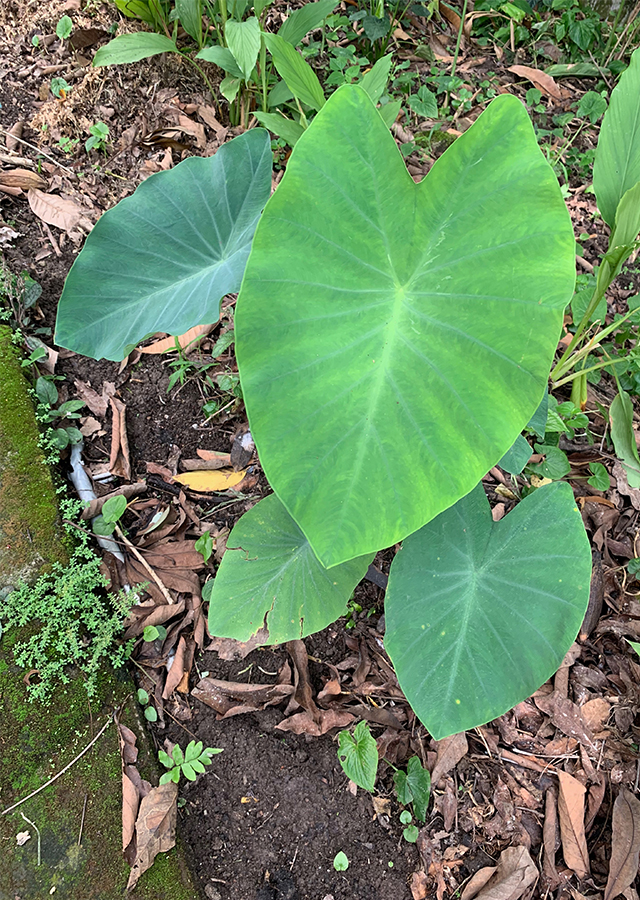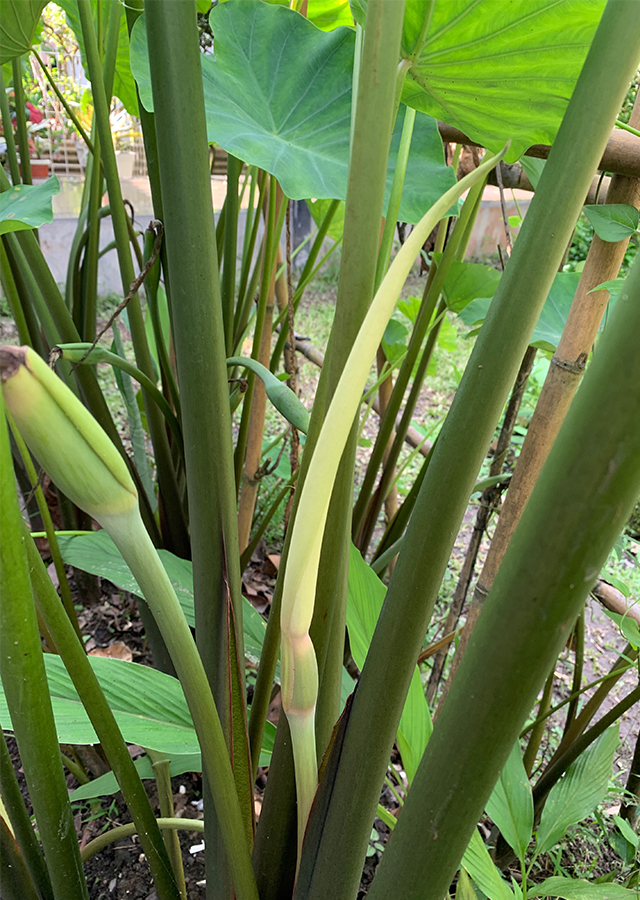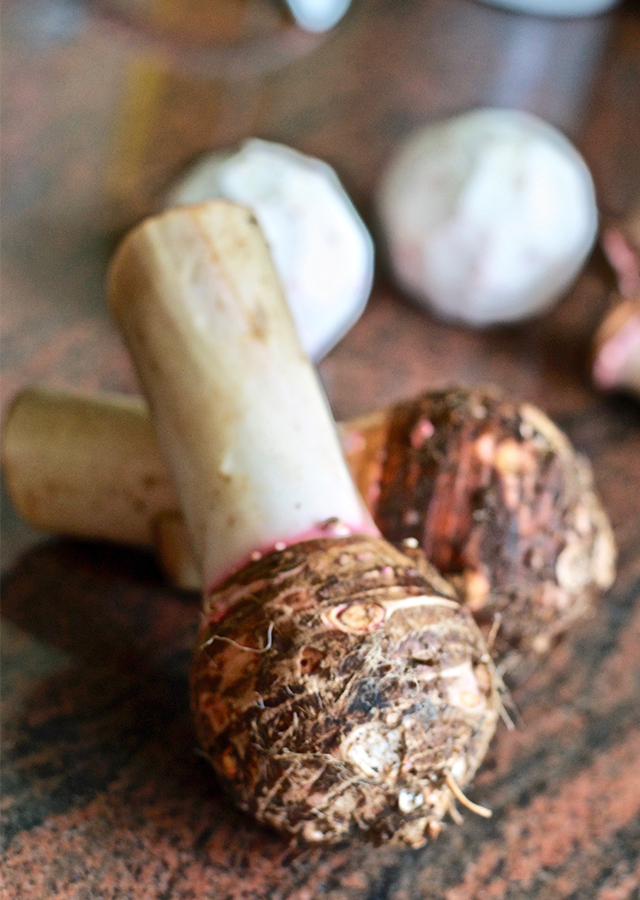Taro
Colocasia esculenta (L.) Schott
Araceae
Location in our garden
Principal



Synonym
Alocasia dussii Dammer
Alocasia illustris W.Bull
Aron colocasium (L.) St.-Lag.
Habitus
Herbaceous. A glabrous, acaulescent, herbaceous, mainly diploid, perennial plant growing up to 50 to150 cm high.
Part Used
Leaves
Roots
Twigs
Tuber
Growing Requirements
Need Shade
Habitat
Wetland
Riverbanks
Forest
Grassland
Terrestrial
Overview
Taro (Colocasia esculenta) is originally from tropical Asia. It seems to have arisen in India and expanded to Burma and China to the East and to Indonesia and other countries to the South. This species has been cultivated as a food source for 6,000 years, and since it accumulates mercury, it also has phytoremediation potential. Since it contains poisonous calcium oxalate that is lost during the cooking process, it should not be consumed fresh. This species has the potential for phytoremediation by accumulating mercury.
Vernacular Names
Yu (China), Arouille carri (French), Alti kachu (India), Imo (Japanese), Koadi (Malaysia), Gabi (Philippines), and Colocasia (Italian), Khoai nuoc (Vietnam).
Agroecology
Taro (Colocasia esculenta) is adapted to grow in a wide range of habitats and substrates ranging from full sun to deep shaded areas. Taro thrives in hot, humid conditions, with average daily temperatures of 21 to 27 °C with annual precipitation of 250 to 1,750 mm distributed evenly during the growing season. It rises from sea level to an elevation of 2,400 m. It tolerates a wide variety of types of soil but does best with a high water table and a pH range of 5.5 to 6.5 on thick, well-drained, friable loams, especially alluvial loams.
Morphology
- Root - the system is adventive, fibrous, and shallow. Huge (up to 4 kg), cylindrical or spherical storage stem (corm), up to 30 x 15 cm, usually brown, with lateral buds above leaf scars, giving rise to new cormels, suckers, or stolons.
- Leaves - large, smooth, heart-shaped to arrow-shaped and have distinct veins (0.6 m long, 0.5 m wide). The thick, fleshy petiole is usually purple.
- Flowers - inconspicuous, unisexual, with female flowers on top and male flowers below, arranged along a spadix (35 cm long). A long, thin, yellow spathe (the modified leaf that resembles a hood-like petal) encircles the spadix.
- Fruit - a many-seeded berry, densely packed and forming ahead of fruit.
- Seeds - with copious endosperm are ovoid to ellipsoid, less than 2 mm long.
Cultivation
Propagated by seeds, corms/tubers, and root suckers.
Chemical Constituents
Flavonoids, ß-sitosterol, steroids, alkaloids, saponins, and tannins, amino acids, anthocyanins perlargonidin, 3-glucoside, cyaniding 3-rhamnoside and cyaniding 3-glucoside.
Traditional Medicinal Uses
- The leaf juice is styptic, stimulant, and rubefacient, and is helpful in internal hemorrhages, otalgia, adenitis, bulbous, and external treatment of eczema.
- The juice of the corm/tuber is used in cases of alopecia, laxative, demulcent and anodyne.
- The leaves in New Guinea are heated over a fire and applied to boils as a poultice.
- In Asia and Africa, this species is used to treat arterial hypertension, liver problems, ulcers, snakebites, and rheumatism.
- Corm raspings are applied as a poultice to mature boils.
- The ash of the tuber mixed with honey is applied for aphthae in the mouth. The heated tubers are locally applied to painful parts.
- The roots are used in catarrh and colic.
- The raw juice of taro is given to drink, mixed with sugar, as a febrifuge.
Part Used
Reference Sources
- CABI. (2020). Invasive Species Compendium: Colocasia esculenta (taro). Centre for Agriculture and Bioscience International (CABI) Web. https://www.cabi.org/isc/datasheet/17221 (Accessed 06-11-2020)
- Fern, K. (2019). Useful Tropical Plants: Colocasia esculenta (L.) Schott. Useful Tropical Plants Database Web. http://tropical.theferns.info/viewtropical.php?id=Colocasia+esculenta (Accessed 08-08-2020)
- HealthBenefitstimes. (2020). Taro facts and health benefits. HealthBenefitstimes Web. https://www.healthbenefitstimes.com/taro/ (Accessed 23-09-2020)
- Lim, T.K. (2014). Edible Medicinal and Non-Medicinal Plants Vol. 9: Modified Stems, Roots, Bulbs. New York: Springer. pp. 454-492.
- NParks Flora & Fauna. (2020). Flora & Fauna Web: Colocasia esculenta (L.) Schott. NParks Flora & Fauna Web. https://www.nparks.gov.sg/florafaunaweb/flora/1/8/1835 (Accessed 08-08-2020)
- StuartXchange. (2020). Philippines Medicinal Plants: Gabi. StuartXchange Web. http://www.stuartxchange.com/Gabi.html (Accessed 08-08-2020)


